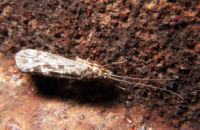
Development and Validation of a Deep Learning Model to Predict the Occurrence and Severity of Retinopathy of Prematurity.
Sign Up to like & getrecommendations! Published in 2022 at "JAMA network open"
DOI: 10.1001/jamanetworkopen.2022.17447
Abstract: Importance Retinopathy of prematurity (ROP) is the leading cause of childhood blindness worldwide. Prediction of ROP before onset holds great promise for reducing the risk of blindness. Objective To develop and validate a deep learning… read more here.
Keywords: rop; validation; severity; deep learning ... See more keywords

Co-occurrence of BAP1 and SF3B1 mutations in uveal melanoma induces cellular senescence.
Sign Up to like & getrecommendations! Published in 2021 at "Molecular oncology"
DOI: 10.1002/1878-0261.13128
Abstract: Uveal melanoma (UM) is the most common intraocular tumor in adults. Recurrent mutations in BRCA1-associated protein 1 (BAP1) and splicing factor 3B subunit 1 (SF3B1) display a mutually exclusive pattern in UM, but the underlying… read more here.
Keywords: melanoma; sf3b1; bap1; senescence ... See more keywords

Occurrence characteristics of relativistic electron microbursts from SAMPEX observations
Sign Up to like & getrecommendations! Published in 2017 at "Journal of Geophysical Research"
DOI: 10.1002/2017ja024067
Abstract: We study the occurrence of relativistic microbursts observed by the Solar Anomalous Magnetospheric Particle Explorer (SAMPEX) satellite. An algorithm is used to identify 193,694 relativistic microbursts in the > 1.05 MeV electron fluxes occurring across… read more here.
Keywords: mlt distribution; occurrence; relativistic microbursts; electron ... See more keywords

Real-time prediction of the occurrence of GLE events
Sign Up to like & getrecommendations! Published in 2017 at "Social Work"
DOI: 10.1002/2017sw001605
Abstract: A tool for predicting the occurrence of Ground Level Enhancement (GLE) events using the UMASEP scheme [Nunez, 2011, 2015] is presented. This real-time tool, called HESPERIA UMASEP-500, is based on the detection of the magnetic… read more here.
Keywords: gle; real time; gle events; occurrence ... See more keywords

Occurrence of lemurs in landscapes and their species‐specific scale responses to habitat loss
Sign Up to like & getrecommendations! Published in 2020 at "American Journal of Primatology"
DOI: 10.1002/ajp.23110
Abstract: Studies on the impact of habitat loss on species occurrence consistently find that the amount of habitat (measured as patch area) is a major determinant of species occurrence at a patch‐level. However, patch‐level research may… read more here.
Keywords: level; landscape; occurrence; habitat loss ... See more keywords

Co‐occurrence dynamics of endangered Lower Keys marsh rabbits and free‐ranging domestic cats: Prey responses to an exotic predator removal program
Sign Up to like & getrecommendations! Published in 2018 at "Ecology and Evolution"
DOI: 10.1002/ece3.3954
Abstract: Abstract The Lower Keys marsh rabbit (Sylvilagus palustris hefneri) is one of many endangered endemic species of the Florida Keys. The main threats are habitat loss and fragmentation from sea‐level rise, development, and habitat succession.… read more here.
Keywords: predator removal; marsh rabbits; occurrence; site ... See more keywords

Seeing is believing? Comparing plant–herbivore networks constructed by field co‐occurrence and DNA barcoding methods for gaining insights into network structures
Sign Up to like & getrecommendations! Published in 2019 at "Ecology and Evolution"
DOI: 10.1002/ece3.4860
Abstract: Abstract Plant–herbivore interaction networks provide information about community organization. Two methods are currently used to document pairwise interactions among plants and insect herbivores. One is the traditional method that collects plant–herbivore interaction data by field… read more here.
Keywords: network; plant; plant herbivore; method ... See more keywords

Co‐occurrence models fail to infer underlying patterns of avoidance and aggregation when closure is violated
Sign Up to like & getrecommendations! Published in 2022 at "Ecology and Evolution"
DOI: 10.1002/ece3.9104
Abstract: Abstract Advances in multi‐species monitoring have prompted an increase in the use of multi‐species occupancy analyses to assess patterns of co‐occurrence among species, even when data were collected at scales likely violating the assumption that… read more here.
Keywords: avoidance aggregation; closure; occurrence; patterns avoidance ... See more keywords

Landscape factors and allochthonous congeneric species influence Callithrix aurita occurrence in Brazilian Atlantic Forest remnants
Sign Up to like & getrecommendations! Published in 2023 at "Ecology and Evolution"
DOI: 10.1002/ece3.9968
Abstract: Abstract The buffy‐tufted‐ear marmoset (Callithrix aurita) is a small primate endemic to the Brazilian Atlantic Forest biome, and one of the 25 most endangered primates in the world, due to fragmentation, loss of habitat, and… read more here.
Keywords: callithrix aurita; brazilian atlantic; aurita occurrence; atlantic forest ... See more keywords

Frequency of invasive plant occurrence is not a suitable proxy for abundance in the Northeast United States
Sign Up to like & getrecommendations! Published in 2017 at "Ecosphere"
DOI: 10.1002/ecs2.1800
Abstract: Measuring and predicting invasive plant abundance is critical for understanding impacts on ecosystems and economies. Although spatial abundance datasets remain rare, occurrence datasets are increasingly available across broad regional scales. We asked whether the frequency… read more here.
Keywords: invasive plant; proxy abundance; occurrence; abundance ... See more keywords

Estimation of metapopulation colonization rates from disturbance history and occurrence pattern data.
Sign Up to like & getrecommendations! Published in 2019 at "Ecology"
DOI: 10.1002/ecy.2814
Abstract: Occurrence patterns of many sessile species in dynamic landscapes are not in equilibrium due to their slow rates of metapopulation colonization and extinction. Colonization-extinction data enable the estimation of colonization rates for such species, but… read more here.
Keywords: occurrence pattern; pattern data; occurrence; colonization ... See more keywords